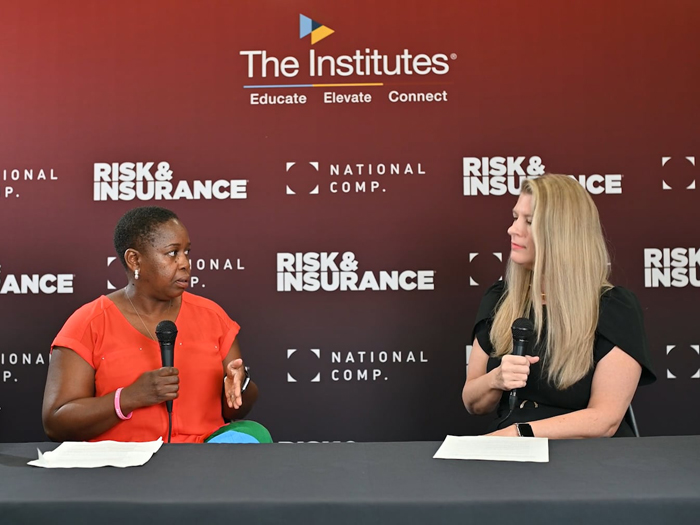Do You Want to Empower Workers to Prevent Injury? Teach Them that Exercise Is Medicine

One of the most necessary and crucial techniques for preventing worker injury is ensuring proper practices are in place well before said injury occurs.
Specifically, preventing back injuries among employees is essential — not only for the physical health of workers but for the health of a company or organization as well. For an individual who becomes injured, the mental setbacks are just as debilitating as the physical ones.
“Occupation is a large part of who a person is,” said Tamara Fryer, physical therapist for the Ochsner Health System. “Losing that is losing a sense of self.”
Fryer — along with Dr. Sean McCoy, executive director of the Florida Masonry Apprentice & Educational Foundation — presented at this year’s National Comp conference about how high-risk industries can best prepare their employees to prevent injuries, especially to the back and neck.
The session entitled “What One High-Risk Industry Is Learning About Back Safety Intervention” discussed the impacts of back injury, treatment options, reinjury mitigation risks, and best practices for employers to implement for their workers.
Neck and Back Pain: Common, Costly and Confusing
One of the things that makes back pain so concerning for employees on the job is its frequency. According to the session, 60 to 80% of adults will experience some sort of back pain that impacts their typical daily functions. The statistic on experiencing neck pain is also sobering: 20 to 70% of adults will have neck pain that interferes with their daily functions.
To provide a more real-time statistic, three out of five people have likely experienced some level of back pain in the past three months.
Additionally, the mere presence of neck or back pain is an indicator of its likely recurrence.
Not only is the prevalence of constant neck and back pain detrimental to an individual’s productivity, but the costs of injury management can also be staggering to an employer.
“[Neck and back pain] are one of the most common reasons people go to the doctor,” Fryer said. “Tests or imaging are ordered, medications are ordered, and it just dries up this cycle of utilization and health care costs, without improvement.”
The prescribed use of opioids not only increases the chances an injured worker will become dependent on the drug, but it’s also a main driver of increased health care costs. According to estimates, opioid misuse disorder and related deaths cost the health care industry tens of billions of dollars each year.
When it comes to treatment plans, the options seem endless. And while this can be viewed as a benefit, for back and neck pain treatment, it creates confusion. The session explained that health care professionals have an arsenal of over 30 treatment approaches for those experiencing neck and back pain, as well as multiple vocabularies and points of view.
“It’s very difficult to manage — all these different treatments, diagnoses and verbiage lead to confusion and anxiety [for patients],” Fryer said.
The confusion also serves as a catalyst for cost increases in practice. Extra tests and imaging may result, incurring more costs for the injured worker.
The Healthy Back Program
It’s clear that there are kinks to iron out, not only when it comes to properly treating neck and back pain but also in preventing the injury or discomfort from becoming a normal occurrence.
To do this, Fryer and Ochsner Health System created and implemented what they call the “Healthy Back Program.”
“We needed a solution,” Fryer said, “and that’s why we came up with the Healthy Back Program.”
She continued, “We wanted to look at all of the evidence-based research and develop a program that would be cost-effective and efficient with these individuals.”
The objectives and mission of the program are to focus on exercise as a form of medicine for those workers experiencing neck or back pain while also providing education as to how to adapt one’s lifestyle to prevent recurrent pain.
The program is divided into four separate components that participants will undergo: physical exam, physical therapy, wellness program and health coaching. The physical exam that the injured worker partakes in allows providers to craft a program specific to that individual’s injury and body. Physical therapy exercises are implemented in a similar fashion.
The wellness program component is designed to take flight once the injured worker has completed the necessary physical training; it focuses on “maintaining strength gains, delivery of health and wellness education, and preparation for independent exercise,” according to the presentation.
The results from the program have been worthwhile: From 2018 to 2021, more than 700 health care employees and 4,500 patients have participated in Ochsner’s Healthy Back Program, and participants have recorded a 65% improvement in pain, 80% increase in low back strength and 47% increase in range of motion.
The program is undoubtedly contributing to lower health care costs while also improving the day-to-day lives of people afflicted with injury and discomfort.
“We’ve talked about cost savings, but we’re also making a difference in people’s lives,” Fryer said.
Lessons in Action
The session continued as McCoy, who works in the masonry and construction industry, shared the types of equipment that can be used to help workers avoid injury.
McCoy, who wore an exoskeleton suit throughout the session, provided a breakdown of the masonry and construction industry, including the statistic that the average age of an industry worker is 46.8 years old.
In terms of industry injury rates, masonry and construction recorded injury rates 24% higher than those “across all industries, on average, in 2020,” according to the presentation. In addition, injuries to construction workers total more than $170 billion each year.
Injuries that construction workers could experience fall into four main categories: falls, getting struck by an object, getting caught between objects and electrocutions.
McCoy provided real-life scenarios and statistics about the impact of consistent worker injury and pain, then offered the use of exoskeleton equipment as a possible solution.
“The exoskeleton is looking to keep people persistent in the profession,” he said.
When a worker wears the exoskeleton, they can safely and correctly maintain certain positions for long periods of time. With the support of the equipment, workers are less likely to experience discomfort, pain or — in the most unfortunate cases — injury.
Prevention Is Key
Ultimately, both Fryer and McCoy stressed the reality of neck and back pain recurrence; it will never be just a one-time injury. Because of this, it’s imperative to not only treat the injury at hand but also incorporate practices that will lessen the frequency of reinjury.
The session concluded by looking forward to new and emerging data and technologies that are enabling employees to mitigate injuries before they even occur. &










